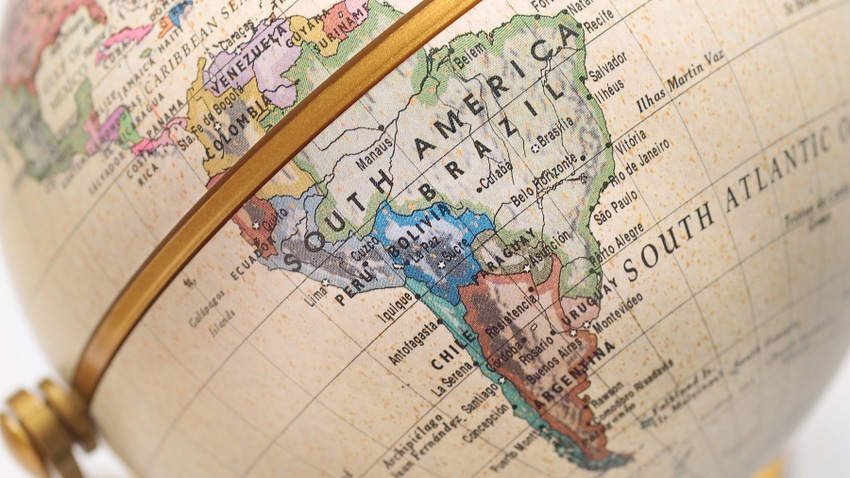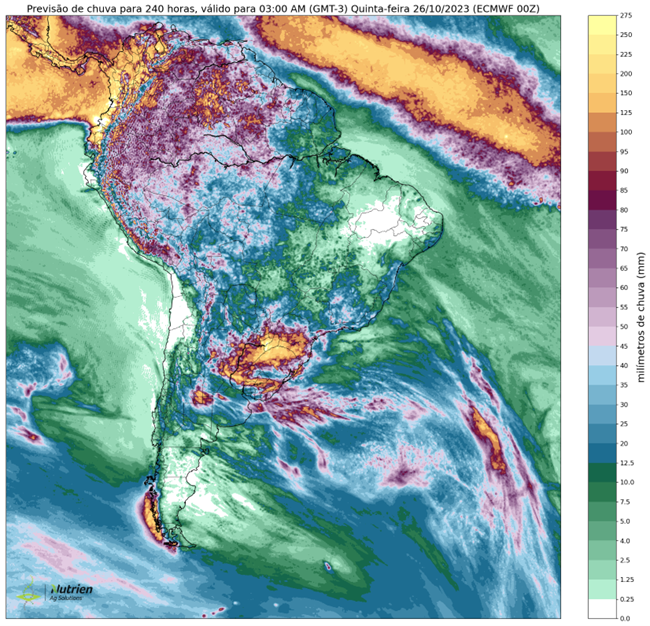
Brazil’s soybean planting pace grinds forward reaching close to 20% overall, with forecasts calling for continued dryness in the Northern region. Brazil has now reached its prime planting window for Mato Grosso, where we should see planting progress accelerate in the next couple of weeks.
The Mato Grosso Institute of Agricultural Economics (IMEA) shows us that as of October 13, Mato Grosso was already 35% planted and will likely be 45% planted when this goes online. While this is slightly behind last year’s pace, it is still above the historical 5-year average.
At its current pace, Mato Grosso will likely reach close to 85% by the end of the month.
As we stated last week, planting will continue but likely at a slower pace as farmers are reluctant to plant without solid moisture in the forecast.
Rainfall favors the western half of the state of Mato Grosso in the ten-day forecast, and then begins to dissipate while heading east, to the point that the Eastern half of the state should not expect much of anything. In fact, with high temperatures evaporating what little moisture there is, it may force some regions to replant.
The center part of the state, where most production is concentrated, could see up to an inch of rainfall. This is not enough to build soil moisture, especially as heat levels remain elevated; but it could be enough to get the crop germinated and keep farmers planting.
While more risk adverse farmers have advanced planting, I spoke with one producer in North Central Mato Grosso who has not yet begun. They are more focused on planting their soybeans in ideal conditions than “rushing” it in exchange to facilitate the second crop corn crop that follows it.
Too wet
Meanwhile, Southern Brazil keeps receiving too much rain, with most areas expected to get another 2” to 6” in the next 10 days. For the most part, the rain is good for what has been planted, except for some reports of yellow corn due to nitrogen leaching. On the other hand, the rain keeps a lid on planting progress. While Mato Grosso is Brazil’s largest soybean producing state, representing 27% of Brazil’s expected soybean production, Parana and Rio Grande Do Sul represent a distant second and third with about 13.5% each. Parana is expected to reach 40% planted this week for soybeans and close to 90% of first crop corn.

10-day forecast
Brazil impacts prices
Global soybean stocks are tight enough that planting progress in Brazil will have an impact on prices in the next couple of weeks. Rainfall levels tend to pick up in Mato Grosso as the season progresses; however, they are currently at half the historical levels for the month. October usually sees an average closer to 4.5”.
Probably more important than total rainfall, is the distribution of that rainfall. If all of that rain is concentrated in one event rather than over a period of time, production will drop.
One of the best crops we ever grew in Brazil was when total volume was way below average, but it was well distributed throughout the season. Brazil’s Cerrado soils have very low water holding capacity and so the crops live hand to mouth a lot more than Midwest crops do.
Matthew Kruse is President of Commstock Investments. Subscribe to their report at www.commstock.com.
Futures trading involves risk. The risk of loss in trading futures and/or options is substantial and each investor and/or trader must consider whether this is a suitable investment. Past performance is not indicative of future results. Trading advice is based on information taken from trades and statistical services and other sources that CommStock Investments believes to be reliable. We do not guarantee that such information is accurate or complete and it should not be relied upon as such. Trading advice reflects our good faith judgment at a specific time and is subject to change without notice. There is no guarantee that the advice we give will result in profitable trades.
About the Author(s)
You May Also Like






